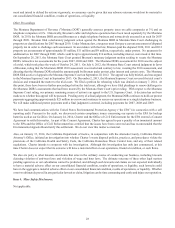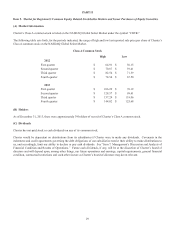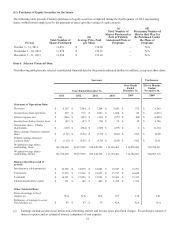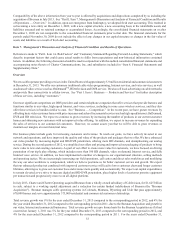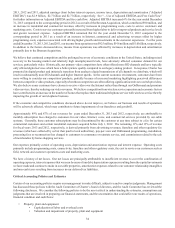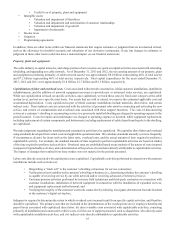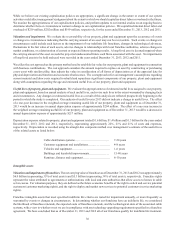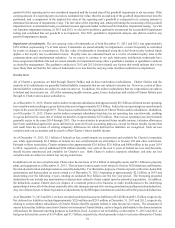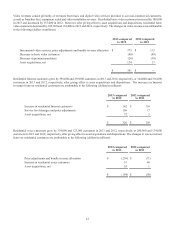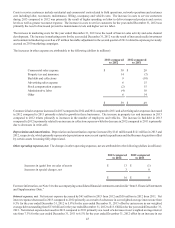Charter 2013 Annual Report Download - page 52
Download and view the complete annual report
Please find page 52 of the 2013 Charter annual report below. You can navigate through the pages in the report by either clicking on the pages listed below, or by using the keyword search tool below to find specific information within the annual report.38
goodwill of the reporting unit is not considered impaired and the second step of the goodwill impairment is not necessary. If the
carrying amount of a reporting unit exceeds its estimated fair value, then the second step of the goodwill impairment test must be
performed, and a comparison of the implied fair value of the reporting unit’s goodwill is compared to its carrying amount to
determine the amount of impairment, if any. The fair value of the reporting unit, when performing the second step of the goodwill
impairment test, is determined using a consistent income approach model as that used for franchise impairment testing. As with
our franchise impairment testing, in 2013 and 2012, we elected to perform a qualitative assessment for our goodwill impairment
testing and concluded that our goodwill is not impaired. Our 2011 quantitative impairment analysis also did not result in any
goodwill impairment charges.
Impairment of trademarks. The net carrying value of trademarks as of both December 31, 2013 and 2012 was approximately
$158 million (representing 1% of total assets). Trademarks are tested annually for impairment, or more frequently as warranted
by events or changes in circumstances. The fair value of trademarks is determined using the relief-from-royalty method which
applies a fair royalty rate to estimated revenue. Royalty rates are estimated based on a review of market royalty rates in the
communications and entertainment industries. As we expect to continue to use each trade name indefinitely, trademarks have
been assigned an indefinite life and are tested annually for impairment using either a qualitative analysis or quantitative analysis
as elected by management. The qualitative analysis in 2013 and 2012 did not identify any factors that would indicate that it was
more likely than not that the fair value of trademarks were less than the carrying value and thus resulted in no impairment.
Income taxes
All of Charter’s operations are held through Charter Holdco and its direct and indirect subsidiaries. Charter Holdco and the
majority of its subsidiaries are generally limited liability companies that are not subject to income tax. However, certain of these
limited liability companies are subject to state income tax. In addition, the indirect subsidiaries that are corporations are subject
to federal and state income tax. All of the remaining taxable income, gains, losses, deductions and credits of Charter Holdco pass
through to Charter and its direct subsidiaries.
As of December 31, 2013, Charter and its indirect corporate subsidiaries had approximately $8.3 billion of federal tax net operating
loss carryforwards resulting in a gross deferred tax asset of approximately $2.9 billion. Federal tax net operating loss carryforwards
expire in the years 2021 through 2033. These losses resulted from the operations of Charter Holdco and its subsidiaries. In addition,
as of December 31, 2013, Charter and its indirect corporate subsidiaries had state tax net operating loss carryforwards, resulting
in a gross deferred tax asset (net of federal tax benefit) of approximately $276 million. State tax net operating loss carryforwards
generally expire in the years 2014 through 2033. Due to uncertainties in projected future taxable income, valuation allowances
have been established against the gross deferred tax assets for book accounting purposes, except for future taxable income that
will result from the reversal of existing temporary differences for which deferred tax liabilities are recognized. Such tax loss
carryforwards can accumulate and be used to offset Charter’s future taxable income.
As of December 31, 2013, $2.1 billion of federal tax loss carryforwards are unrestricted and available for Charter’s immediate
use, while approximately $6.2 billion of federal tax loss carryforwards are still subject to Section 382 and other restrictions.
Pursuant to these restrictions, Charter estimates that approximately $2.0 billion, $2.0 billion and $400 million in the years 2014
to 2016, respectively, and an additional $226 million annually over each of the next 8 years of federal tax loss carryforwards,
should become unrestricted and available for Charter’s use. Both Charter’s indirect corporate subsidiary and state tax loss
carryforwards are subject to similar but varying restrictions.
In addition to its tax loss carryforwards, Charter also has tax basis of $5.2 billion in intangible assets and $5.1 billion in property,
plant, and equipment as of December 31, 2013. The tax basis in these assets is not subject to Section 382 limitations and therefore
the related amortization and depreciation is currently deductible. For illustrative purposes, Charter expects to reflect tax-deductible
amortization and depreciation on assets owned as of December 31, 2013, beginning at approximately $2.2 billion in 2014 and
decelerating over the following 4 years, totaling an estimated $6.6 billion over the five year period. The foregoing projected
deductions do not include any amortization or depreciation related to future capital spend or potential acquisitions. In addition,
the deductions assume Charter does not dispose of a material portion of its business or make modifications to the underlying
partnerships it owns, all of which may materially affect the timing or amount of its existing amortization and depreciation deductions.
Any one of these factors or future legislation or adjustments by the IRS upon examination could also affect the projected deductions.
As of December 31, 2013 and 2012, we have recorded net deferred income tax liabilities of $1.4 billion and $1.3 billion, respectively.
Net deferred tax liabilities included approximately $226 million and $219 million at December 31, 2013 and 2012, respectively,
relating to certain indirect subsidiaries of Charter Holdco that file separate federal or state income tax returns. The remainder of
our net deferred tax liability arose from Charter's investment in Charter Holdco, and was largely attributable to the characterization
of franchises for financial reporting purposes as indefinite-lived. As part of our net liability, on December 31, 2013 and 2012, we
had gross deferred tax assets of $3.9 billion and $3.7 billion, respectively, which primarily relate to tax losses allocated to Charter


